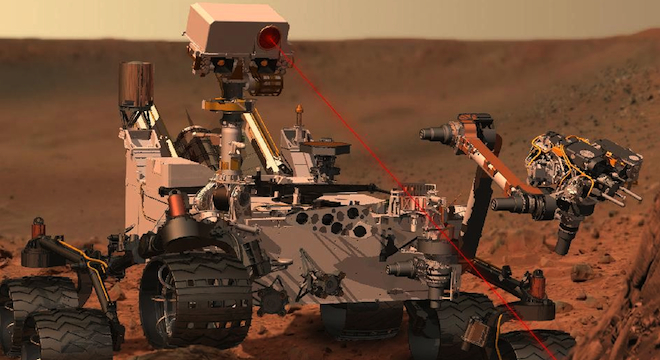Updated 1:16 p.m. ET, Tuesday, July 24
NASA’s most advanced Mars rover, Curiosity, is a little under two weeks away from its scheduled landing on the Martian surface.
The August 6th landing is expected to be a nail-biting seven-minute long ordeal unlike anything NASA has attempted before, during which time the rover’s landing craft is supposed to abruptly slow from 13,000 miles-per-hour to zero, with the craft entering the Martian atmosphere, deploying a supersonic parachute, ejecting its heat shield, then the parachute itself, then igniting rocket thrusters underneath the rover, then the landing craft finally activating a “sky crane” to gently lower the rover into Mars’s Gale Crater near Mount Sharp, where scientists believe that liquid water once flowed over Mars’s surface.
“Landing on Mars is always risky,” said NASA Mars Exploration Program Director Doug McCuistion in a press briefing on the landing on July 16, “There are many unknowns Mars throws at you: Dust storms, atmospheric challenges, wind.”
Check out the trajectory of the landing in the following video simulation and graphic from NASA’s Jet Propulsion Laboratory, which is in charge of the mission.

But if all goes according to plan, the nuclear-powered Curiosity rover, officially designated the “Mars Science Laboratory,” will touch down on the Martian surface at 1:31 a.m. Eastern, Monday, August 6.
Onboard the 10-foot-long, 9-foot-wide, 7-foot-tall rover (NASA’s Jet Propulsion Laboratory notes it is about the size of a compact SUV), are 10 different instruments, among them a military-grade laser designed to vaporize rock samples to better analyze their composition.
The laser fires extremely short, invisible-to-the-naked-eye pulses, each lasting 5 billionths of a second, but containing more than a megawatt of power, enough to put it on par with some anti-missile lasers. The laser, as is the case with the other instruments, is powered by the rover’s battery, itself charged by the radioactive decay of plutonium-238 onboard.
The 20-pound laser and telescope known as the Chemical and Camera instrument, or “ChemCam,” is due to be fired-up on around August 10, according to scientists at Los Alamos National Laboratory in New Mexico, where the instrument was originally developed.
“If all goes well we plan to use it within a week of landing, but we will have to wait and see,” said Roger Wiens, principal investigator of the Mars Science Laboratory’s ChemCam team, in an email to TPM.
Wiens further told TPM that the laser had a “design lifetime” of 5 million shots, more than enough to take it past the 2-year-working lifetime for the entire rover itself, according to NASA.
Before it gets to blasting any rocks to establish their constituent materials — scientists are keen to find any deposits of water or ice — the ChemCam will first have to be calibrated. This involves checking to ensure the instrument is working properly before it is extended on a mast above the rover. Then, the telescope portion of the instrument will “take images of a calibration target” mounted on the rover itself, according to Los Alamos National Laboratory spokesman James Rickman, in an email to TPM.
“After getting back images of the Mars surface surrounding the rover, the team will select the first sample,” for vaporizing, Rickman told TPM. “If there are rocks near the rover, we will pick one of them as the first target, otherwise ChemCam will start by characterizing the soil.”
The data taken by ChemCam will be sent back to Earth via a radio transmission, first to one of three satellites currently orbiting the Red Planet (the NASA’s Mars Reconnaissance Orbiter and the NASA’s Odyssey orbiter and the European Space Agency’s Mars Express ), then back to NASA Deep Space Network satellite dishes on Earth.
“The data transmission takes a little over a half hour plus the time it takes to travel to Earth, which ranges between three and twenty minutes depending on the positions of the planets in the solar system,” Rickman told TPM.
One of the satellites, the Odyssey, recently gave NASA scientists a bit of a scare when it suffered a glitch and entered “safe mode,” possibly further obscuring Curiosity’s landing, but fortunately Odyssey is now back in working order, helping to ensure that the rover gets to the surface in-tact.
As impressive as the laser may be, the other nine instruments are of equal importance in the Curiosity’s overall mission, the objective of which is to “assess whether the landing area has ever had or still has environmental conditions favorable to microbial life, both its habitability and its preservation.”
Check out the following video simulation of Curiosity’s instruments in action from NASA. The ChemCam is the camera-like instrument poking out of the top-center of the rover.
At last check — an in-flight test on March 16– the ChemCam laser was functioning properly, according to Los Alamos National Laboratory scientists.
“The test took less than half an hour and everything checked out fine,” Rickman told TPM. “The instrument will stay off until its next check-out shortly after landing.”
Correction: This article originally incorrectly stated that the landing date of Curiosity was set for Wednesday, August 6, when in fact, the actual date is Monday, August 6, 2012. The error has since been corrected in copy and we regret it.






